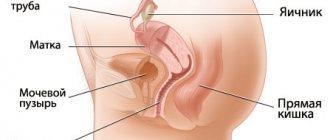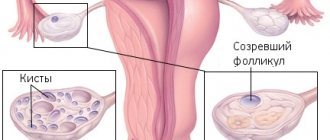Colpitis during pregnancy, like colpitis in general, is an inflammatory process in the vaginal mucosa, affecting the cervix. This is one of the most common pathologies among women of childbearing age. It can manifest as an acute inflammatory process or have a chronic course.
Almost every woman has had colpitis of varying degrees of complexity. The disease does not always manifest itself and sometimes occurs in a mild, asymptomatic form. For example, colpitis can be a consequence of stressful situations or hypothermia, in these cases it goes away on its own.
But, if the cause of vaginitis is more serious than hypothermia, then the consequences can be much more severe. Timely and complete treatment of colpitis during pregnancy is especially important.
What is colpitis?
Colpitis, or vaginitis, is said to occur when the vaginal mucosa becomes infected with pathogens, resulting in an inflammatory process. Vaginal discharge, which contains large quantities of pathogenic microbes and their metabolic products, irritates the external genitalia, resulting in vulvitis (that is, damage to the vulva).
Colpitis during pregnancy occurs in a large percentage of expectant mothers, according to some data reaching 70 - 80%. It is typical that the disease can develop at any stage of pregnancy, but the occurrence of vaginitis in the third (often before childbirth) trimester is especially dangerous.
Depending on the microbial agents that caused the development of the disease, colpitis is divided into specific and nonspecific. Nonspecific vaginitis is spoken of when the etiological factor of the disease is opportunistic flora, that is, those microorganisms that are normally part of the vaginal microbiocenosis in small quantities and for the time being behave peacefully (see causes of thrush in women). If colpitis is caused by pathological microorganisms (Trichomonas, chlamydia, gonococci and others), a diagnosis of specific colpitis during pregnancy is made.
Reasons and what threat it poses
How is colpitis during pregnancy dangerous, what is it, what is the risk for the child?
Like other types of inflammatory diseases, vaginitis can often appear during periods when the body is especially vulnerable to attacks from pathogens. When the body's protective functions deteriorate, pathogenic agents can develop unhindered. The causative agents of inflammatory processes during pregnancy include: ureaplasma, genital herpes, chlamydia, gonococcus, trichomonas, candida. Gynecology often describes cases of bacterial vaginosis, especially in the early stages of gestation, when the balance between normal and pathogenic microflora is disturbed.
Provoking factors that cause colpitis include:
- Mechanical microtrauma or damage to the surface of the mucous membrane or vulva.
- Lack of proper self-care activities. Inadequate personal hygiene measures.
- The development of allergic reactions to certain medications.
- Also, such a pathology may be caused by too frequent douching, especially without obvious reasons (for example, if a woman is afraid of the development of infectious processes, she often sanitizes the birth canal, while positive microorganisms are washed away, creating a favorable microflora for the development of diseases.
- Treatment with antibacterial drugs.
- Pathological processes in the organs of the endocrine system.
It is important to remember that colpitis during gestation can have negative consequences for the child. Its danger, first of all, is that there is a possibility of developing an infectious process, but if timely therapy is not available, the following complications may appear:
- intrauterine growth retardation;
- premature delivery in the third trimester or spontaneous termination of pregnancy in the first trimester of gestation;
- presence of polyhydramnios;
- infection of placental tissues, due to which fetoplacental insufficiency develops, oxygen starvation in the fetus and delayed development;
- infection of the baby during passage through the birth canal during labor.
Considering the dangerous complications, it is important to contact the gynecologist leading the pregnancy as early as possible so that he can prescribe adequate treatment using medications approved at this time. It must be remembered that self-treatment is unacceptable.
What does it come from?
Pregnancy is one of the conditions that predisposes to the occurrence of colpitis. This predisposition is due to two factors.
Firstly, during the period of gestation, the body experiences immunosuppression, that is, its protective forces are suppressed (nature protects the fetus from being rejected by the mother’s body). Secondly, during pregnancy the hormonal background changes, as a result of which the environment in the vagina also changes; instead of acidic, it becomes alkaline, which acts as a trigger for the growth and development of opportunistic or pathogenic flora. But risk factors for developing the disease during pregnancy include the following:
- early onset of sexual activity;
- promiscuity, even in the past;
- undergoing a course of antibiotic treatment;
- passion for tight underwear;
- underwear made of synthetic materials;
- errors in nutrition;
- allergic reactions (to personal hygiene products);
- mechanical and/or chemical damage to the vaginal mucosa (for example, during douching);
- neglect of the rules of intimate hygiene;
- chronic endocrine pathology.
Why is colpitis dangerous during pregnancy?
During pregnancy, colpitis creates a particular inconvenience, but in fact, colpitis itself is not as terrible as its possible consequences, for example, the likelihood of an ascending infection (it can harm the developing fetus during gestation, and also pose a danger to the child during childbirth). In addition, in pregnant women, inflammation of the vaginal mucosa can cause miscarriage and infection of the fetus, or lead to contamination of amniotic fluid and the development of pregnancy complications (polyhydramnios, premature birth, etc.).
In the future, a woman may experience difficulty conceiving a child due to chronic colpitis. And almost always advanced, untreated vaginitis leads to endometritis and other lesions.
Colpitis can be infectious or bacterial. In pregnant women, it often occurs due to changes in hormonal levels and a malfunction of the immune system.
More on the topic
Is it possible to avoid toxicosis during pregnancy?
Candidiasis during pregnancy: is it dangerous for the baby?
Cervical erosion during pregnancy
How dangerous is cytomegalovirus during pregnancy and when is treatment necessary?
Dental treatment during pregnancy
How does vaginitis manifest?
The symptoms of colpitis during pregnancy are practically no different from those in women in a “non-pregnant” state. A pathognomic sign of the disease is discharge.
- In the acute phase of the discharge process, the discharge is very pronounced (which differs somewhat from their amount in other women), their volume is so large that they invariably end up on the labia majora and minora, causing their irritation and maceration.
- If the process is neglected and intimate hygiene is not observed, the discharge irritates the skin of the inner thighs and pubis.
- The skin becomes bright red and itchy.
- When examined in the speculum, intense hyperemia of the vaginal mucosa and swelling are observed. Clumps of off-white, yellow or greenish color are visible on the walls of the vagina.
- The discharge, depending on the nature of the causative agent of the disease, also varies in color (from white to greenish) and has a repulsive odor.
An example from practice: A primigravida came to an appointment (earlier than expected) in the last stages of about 36 - 38 weeks with huge eyes of horror and complaints that her water seemed to be leaking. When asked when this leakage started and why she didn’t immediately call an ambulance, the woman replied: “It started 3 days ago, at first I didn’t even think about water, so there was a little more discharge. And yesterday, before going to bed, I got scared and decided to come to the antenatal clinic.” After examining her on the couch, measuring her abdomen, and listening to the fetal heartbeat, she examined the woman on the chair. One glance was enough to diagnose colpitis; she took the necessary smear and checked the cervical canal for the integrity of the amniotic sac. Treatment was prescribed later, based on test results.
Also, colpitis is characterized by intense itching and burning, both in the vagina and in the area of the external genitalia. A distinctive feature of the described discomfort is that it intensifies while walking, doing physical exercise and the slightest error in diet.
In some cases, or in the absence of appropriate treatment, the discharge is so “harmful” that, as a result of irritation of the cervical mucosa, the process from cervicitis quickly turns into erosion, which is manifested by bloody discharge. Blood discharge, as a rule, is of a contact nature and occurs after direct contact with the cervix (after sexual intercourse or douching). A distinctive feature of vaginitis in pregnant women is the occurrence of aching or nagging pain in the lower abdomen, which is associated with irritation of the vagina and cervix.
Example from practice: A pregnant woman came to the antenatal clinic at the appointed time at 28 weeks - the most threatened period for termination. Complaints of nagging pain in the lower abdomen and small, periodic bleeding. Upon examination, the uterus is in normal tone and does not respond to palpation (that is, it does not contract and “do not turn to stone”, as if there is a threat). When examining the cervix, erosion is visualized, and palpation of the cervix determines its sufficient density corresponding to the period of pregnancy, the cervical canal is closed. I was confused by the discharge (with an unpleasant odor and a yellowish color). I sent the woman to the department for conservation, not forgetting to indicate colpitis in the diagnosis.
Very often, which is again due to changes in the body, yeast colpitis (candidiasis) develops during pregnancy. It manifests itself as copious discharge that has a viscous milky consistency or resembles crumbs of cottage cheese (see symptoms of thrush in women). Often the smell of sour dough is mixed with the discharge. It is typical that discomfort in the form of itching and burning in the vulva and vagina is pronounced. Often the fungus also affects the urethra, which manifests itself in frequent and painful urination (see urethritis in women: symptoms, treatment). If treatment is not started in a timely manner, the infection can rise higher, involving the bladder and even the kidneys.
Symptoms and diagnosis
Symptoms during pregnancy depend on what form of the disease develops - acute or chronic.
Also, clinical signs are directly influenced by the pathogens of the disease. The main symptoms of the development of the pathological process include:
- discharge during pregnancy, usually it is profuse, viscous, viscous, either transparent or whitish, yellowish, curdled (depending on the pathogen);
- hyperthermia may be observed, general health worsens in any trimester of gestation;
- sensations of burning, itching in the area of the external genitalia and in the vaginal cavity;
- painful, aching sensations that are felt in the lower abdomen.
Colpitis in chronic form manifests itself with similar symptoms, but they are less pronounced.
There are periods of outbreaks and remissions; during exacerbations, the state of health worsens, and during remission, all complaints disappear. Clinical manifestations, depending on the pathogen:
- The nonspecific type is characterized by thick, heterogeneous discharge, white or brownish in color, they do not have a pronounced odor, and with prolonged development, painful sensations may appear in the lower abdomen, and there is a burning or itching sensation.
- Bacterial vaginosis is characterized by the appearance of copious, sticky, milky-white or gray discharge, it smells like rotten fish, and burning or itching occurs infrequently.
- Trichomoniasis is characterized by copious, sticky, yellow-green discharge, it smells unpleasant, there may be pain when emptying the bladder, there is itching and burning.
- The candidiasis type is characterized by copious, milky-white discharge, a cheesy consistency, in some cases it has a sour smell, intense itching and burning.
- The gonorrheal type is distinguished by liquid, profuse, yellowish-green or yellow discharge, odorless, there is pain when emptying the bladder and pain in the lower abdomen, there is a burning sensation.
Diagnostic measures include an external gynecological examination and collection of anamnestic data.
Next, the doctor prescribes the following examinations:
- bacterial culture of secretions to determine the pathogen and form;
- PCR for identifying infectious agents.
Next, the specialist will prescribe the correct treatment using medications approved during this period.
Confirmation of the diagnosis of colpitis
To diagnose vaginitis in pregnant women, in addition to collecting complaints and anamnesis, a routine examination of the cervix and vagina in speculum is performed. In this case, all the signs of the inflammatory process are evident:
- swelling of the mucous membranes
- phenomena of cervicitis or cervical erosion
- copious discharge of an unusual color in the form of separate accumulations on the mucous membranes and having an unpleasant odor
Of course, the diagnosis must be confirmed by laboratory research methods:
- microscopy of smears from the vagina and cervix (increased number of leukocytes, detection of pathological or opportunistic flora: Trichomonas, fungi and others);
- examination for sexually transmitted infections (herpes virus, chlamydia, ureaplasma, human papillomavirus and others);
- cultural (bacteriological) examination of smears - inoculation of vaginal leucorrhoea on nutrient media (to identify the pathogen and determine its sensitivity to antibiotics);
- colposcopy if necessary;
- Ultrasound of the uterus and fetus (to confirm the presence/absence of a threat of miscarriage, intrauterine growth retardation, fetoplacental insufficiency).
Diagnostic methods
First of all, before making a diagnosis of colpitis, the gynecologist collects anamnesis and conducts a visual examination using mirrors. Then the pregnant patient may be prescribed the following types of examination:
- Taking smears to determine the vaginal microflora.
- Collection of vaginal secretions for bacteriological examination. During the analysis, the causative agent of the infection and its resistance to antibiotics are determined.
- Ultrasound of the pelvic organs. The study allows you to determine the condition of the uterus and the completeness of the blood supply to the placenta.
- examination to detect sexually transmitted infections.
Additionally, the woman must take a blood and urine test.
Attention! In certain cases, when the pathogen cannot be determined in any other way, a blood test is performed to detect antibodies to TORCH infections.
We treat colpitis
Treatment of colpitis during pregnancy must be carried out without fail, no matter how long the diagnosis was made. Treatment of the disease first begins with a diet (prohibition of eating hot, sour, salty, spicy foods and sweets) and a ban on sexual activity. If possible, it is necessary to identify and eliminate the cause of vaginitis (refusal to wear tight underwear or use intimate hygiene products).
How to treat colpitis during pregnancy is decided by the doctor based on test results. Undoubtedly, antibacterial drugs are crucial. Treatment is usually local and consists of prescribing suppositories, creams and ointments intravaginally.
- Terzhinan (250-300 rub. 6 pcs., 350-400 rub. 10 pcs.), Hexicon (10 pcs. 200-300 rub.) - the drugs of choice for the treatment of colpitis during gestation are Terzhinan and Hexicon suppositories. They are administered one at a time before bedtime for a period of 7–14 days.
- Betadine (300-370 rubles) - it is possible to use betadine suppositories, but only up to 12 weeks, since the iodine included in the suppositories in later periods can affect the functioning of the fetal thyroid gland.
- Polygynax (300-400 rubles) there is no consensus among doctors about this drug; in the instructions for the drug, pregnancy is a contraindication for use, but the use of suppositories is allowed immediately before childbirth (1 - 2 weeks).
- Klion-D 10 pcs 250 rub. (metronidazole and miconazole), Neo-Penotran forte (7 pcs 900 rubles), Metromicon Neo (14 pcs 300-360 rubles), Meratin-Combi - in the case of Trichomonas colpitis, Klion-D and Meratin-Combi suppositories are recommended (1 vaginal one each once a day for 10, maximum 14 days).
- Pimafucin - if colpitis caused by fungi is diagnosed, antifungal suppositories are prescribed: Pimafucin (3 pcs. 300 rubles), Clotrimazole (in the 2nd and 3rd trimesters), Nystatin (low effectiveness) and an old remedy - Sodium tetraborate (borax) in glycerin 20 rubles. (see all suppositories for thrush and how to treat it correctly).
In addition to etiotropic treatment, sitz baths with decoctions of medicinal herbs and vaginal lavage are prescribed. Douching helps mechanically flush out germs from the vagina, but during pregnancy, most doctors do not recommend it, since it may not be safe (you should be especially careful, or abandon this procedure altogether) see the truth about douching - harm and benefit. Douching is prescribed for a period of no more than 4 days (maximum 5).
But baths and irrigation of the external genitalia with warm decoctions are safe, they relieve irritation and relieve inflammation. Medicinal herbs include chamomile, calendula, St. John's wort, coltsfoot, mint and others. Baths are prescribed for up to two weeks.
Treatment of colpitis during pregnancy
We will not open America to you if we tell you that colpitis cannot be treated on your own. Only a competent obstetrician-gynecologist will be able to determine what caused colpitis. Based on the test results, he will prescribe treatment. Keep in mind that a pregnant woman is responsible not only for her own health, but also for the health of the baby.
As a rule, to treat colpitis during pregnancy, chemical medications (including antibiotics), physiotherapy, herbal decoctions, baths with an acidic environment, ointment applications, and a special diet are used.
Treatment of vaginitis in pregnant women is complicated by the fact that many effective medications are not approved for them. For example, widely used drugs, such as nolicin, dalacin, clindacin, have contraindications during pregnancy. And of the other systemic ones (those that are taken orally and act when absorbed into the blood), only nystatin and pimafucin can be used. They are safe even in large doses, but, unfortunately, they are ineffective. Therefore, treatment with these drugs is combined with local treatment (douching with herbal decoctions, taking sitz baths, using vaginal and rectal suppositories, creams or gels).
The popular drug betadine can only be used up to 3 months of pregnancy. At the same time, Terzhinan and Vagotil have no contraindications for pregnant women. As for antibiotics, they are prescribed only after determining the sensitivity of the pathogen to drugs of this series.
If the cause of colpitis is an infection caused by Trichomonas, the doctor prescribes Metronidazole. True, this drug is contraindicated in the 1st trimester of pregnancy, but if necessary, it can be used during the 2nd and 3rd trimesters. Pregnant women with trichomonas colpitis are prescribed Clotrimazole (in the vagina, 100 mg daily for a week). But this only results in a weakening of the symptoms. Cure occurs only in 1/5 of the patients.
Although tetracycline is often used in gynecological practice to treat vaginitis, it should not be prescribed to pregnant women.
Diagnosis of colpitis
The correct treatment of the pathology directly depends on the correct identification of the pathogen, that is, identification of the type of vaginitis. For diagnosis, six laboratory tests are carried out, sequentially or selectively, depending on the completeness of the information content of the analysis.
- An examination by a gynecologist, which allows you to assess the condition of the cervix, the nature of the discharge using a special mirror, as well as the level of acidity based on test results.
- A flora smear that allows you to calculate the average number of leukocytes and the presence of necessary microorganisms.
The first diagnostic measure if any deviation in women’s health is suspected is a smear for flora - Tank culture as a clarifying analysis if a smear does not allow determining the source of infection. The essence of the analysis is that bacteria that cause colpitis in the vagina are grown on a nutrient medium. In parallel with this, tests are usually carried out to determine the sensitivity of bacteria to antibiotics.
- PCR (polymerase chain reaction). This analysis will indicate with 100% accuracy what caused the colpitis.
- Ultrasound. A mandatory analysis to check the condition of the appendages, uterus, and also assess the correctness of blood flow in the placenta.
- Enzyme-linked immunosorbent assay (ELISA). The blood sample being tested will show how many antibodies to the pathogens of TORCH infections are present. Typically, this study is prescribed if there is doubt about the source of the infection.
This is interesting. You need to wash yourself the night before a gynecological examination. Since a hygienic procedure immediately before going to the doctor will blur the objective picture of the diagnosis.
Prevention of colpitis
Vaginitis detected in the early stages is quite easy to treat. However, we must not forget about preventive measures to protect both the woman and her child:
- taking vitamin complexes for pregnant women;
Taking vitamins strengthens the immune system, creating a protective barrier to the development of nonspecific colpitis
- hardening;
- maintaining hygiene (clean underwear, a trusted sexual partner);
- maintaining a diet (moderate consumption of salty, sweet, spicy, smoked foods).
Colpitis during pregnancy is a fairly common problem, which a competent gynecologist can solve without consequences for the woman and child at any stage of gestation. But an important condition for successful treatment is timely treatment of alarming symptoms to a specialist. As well as compliance with basic preventive measures and coordination of any means of therapy with the doctor.
Higher philological education, 11 years of experience teaching English and Russian, love for children and an objective view of modernity are the key lines of my 31-year-old life. Strengths: responsibility, desire to learn new things and self-improvement.
Vaginitis during pregnancy: classification of types
Pathogenic microorganisms that cause colpitis can be of different types, so there are several types of inflammation.
Specific colpitis: causes and pathogens
This type of vaginitis is caused by microorganisms entering the vagina from the outside, that is:
- during sexual intercourse;
- due to non-compliance with personal hygiene rules;
- as a result of unsanitary conditions during a gynecological examination of a woman.
The causative agents of specific vaginitis are:
- gonococci;
- Trichomonas;
- chlamydia;
- Treponema pallidum.
Specific vaginitis is caused by infection from outside
Types of specific colpitis
Depending on the pathogen, specific vaginitis can be of four types.
Table: symptoms of various types of specific vaginitis
| Type of colpitis | Symptoms | Note |
| Gonorrheal |
| In advanced cases, redness can be observed on the thighs and buttocks. However, such a course of the disease is rare, since all women registered with gynecologists are tested for gonorrhea with a vaginal smear. |
| Trichomonas |
| Trichomonas colpitis is transmitted from a sexual partner, as well as through non-compliance with hand hygiene and through dirty linen. |
| Chlamydial colpitis |
| This is a form of exacerbation of chlamydia - one of the TORCH infections, sexually transmitted or caused by hormonal changes. |
This is interesting. TORCH is an acronym based on the initial letters of the names of infections: T - Toxoplasmosis (toxoplasmosis), O - Others (syphilis, hepatitis B, varicella-zoster virus, other viruses and bacteria), R - Rubella (rubella), C - Cytomegalovirus (cytomegalovirus) , H - Herpes simplex virus (herpes simplex virus).
Definition
https://ultraclinic.com.ua/akusher-ginekolog/torch-infekcii/
Nonspecific vaginitis
The causes of this type of colpitis is an imbalance in the vaginal microflora: opportunistic bacteria, which are necessarily present in the vaginal environment, begin to actively multiply and crowd out beneficial lactobacilli.
Table: types, symptoms and causes of nonspecific colpitis
| View | Symptoms | What caused | Note |
| Candidal colpitis or thrush |
|
| If candidal vaginitis in a pregnant woman cannot be cured, the woman should be checked for diabetes mellitus and thyroid hyperplasia. |
| Bacterial | Mucus discharge with a fishy or rotten egg odor. | It is provoked by the rapid proliferation of pathogenic microorganisms (Proteus bacilli, Pseudomonas aeruginosa, diplococci, Gardnerella, Escherichia coli). | — |
| Viral |
| Occurs when the body has:
| — |
| Emphysematous | Bubbles with clear liquid on the vaginal mucosa. |
| As a rule, it goes away without treatment 2–2.5 weeks after birth. |
With bacterial colpitis, rapid proliferation of pathogenic microorganisms occurs
This is interesting. Another type of colpitis - atrophic (senile or postmenopausal vaginitis) - is, as the name suggests, uncharacteristic for pregnant women. The cause of this inflammation is a lack of estrogen in the body and thinning of the vaginal epithelium.
Video: colpitis during pregnancy - general information
Childbirth with colpitis
The diagnosis of colpitis is made not only by symptoms and visual examination. To make an accurate diagnosis, tests confirming the pathology are necessary. With colpitis, leukocytes in the blood should be elevated, and a smear will confirm the pathology and show which pathogenic microorganisms caused it
There have been cases of diagnosis by visual examination, so as not to waste time and not give birth, when a woman has colpitis. But the diagnosis was not always confirmed later, and there could be negative consequences for the child.
Treatment
What is the treatment for vaginitis during pregnancy? To solve the problem, drug therapy is used. Drugs are appropriate only when taking into account the pathogens that predispose to the spread of the disease.
Bacterial vaginitis is eliminated through antibiotics or additional agents that are used to treat the affected areas.
The fungal form is treated with antifungal suppositories and tablets such as Fluconazole.
To eliminate trichomonas lesions, doctors prescribe trichopolum and metronidazole to patients in tablet form.
Non-infectious pathogens are eliminated using intimate hygiene products, medicinal ointments, and sprays.
It is important not to self-medicate! Lack of knowledge about the action of a particular drug will lead to complications and aggravate the course of the disease.
Therapy methods
Treatment of colpitis during pregnancy is carried out regardless of the period. First, a woman must go on a certain diet. It is based on avoiding eating sweet, salty, hot and spicy foods. In addition, during the entire course of therapy, the pregnant patient must refuse sexual intercourse.
The specific drug, as well as the treatment regimen for colpitis in a pregnant woman, is chosen by the attending physician, based on the results of the tests performed. The general treatment regimen is as follows:
- Antifungal drugs . This treatment is prescribed if colpitis is caused by fungi of the genus Candida.
- Antibacterial drugs . The choice of a specific medication depends on the type of pathogen and the length of pregnancy of the woman.
- Antiviral drugs . They are prescribed in cases where colpitis is provoked by a virus.
Important! It should be remembered that both sexual partners must undergo treatment, otherwise relapse of the disease cannot be avoided.
Throughout the entire therapeutic course, a woman must follow a daily routine, get enough sleep and take a complex of vitamins to strengthen the body’s defenses.










